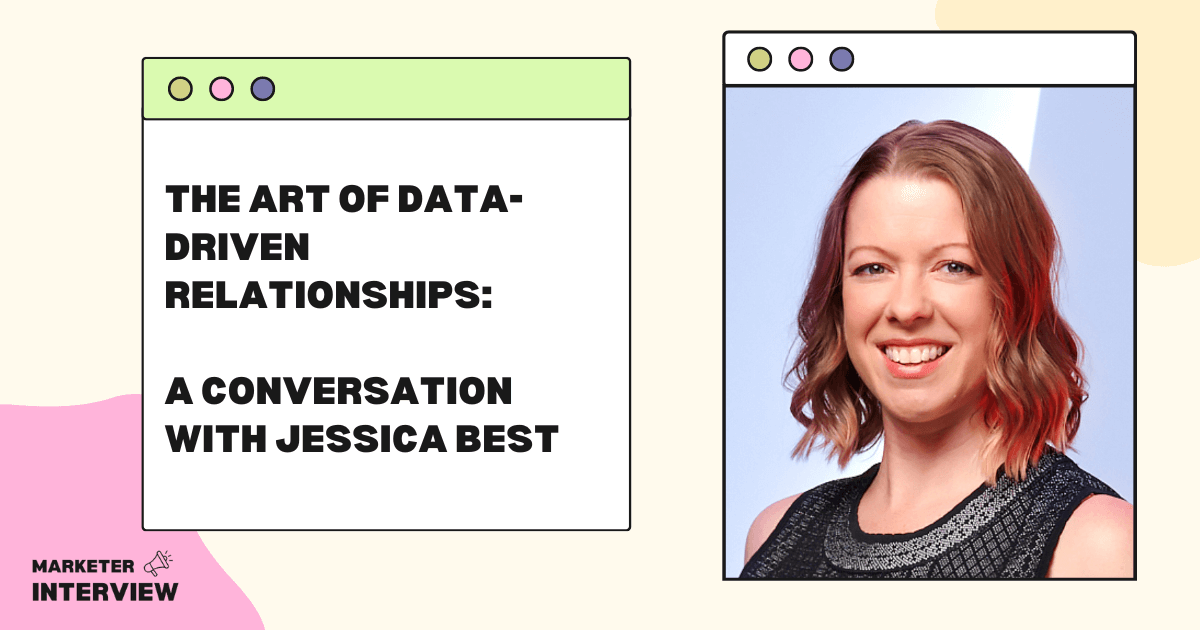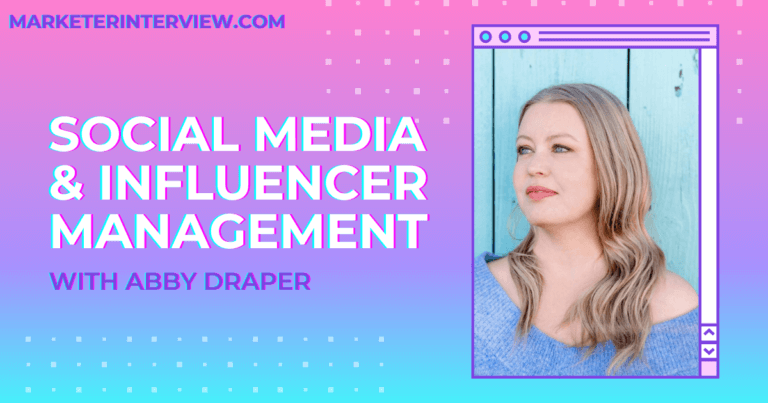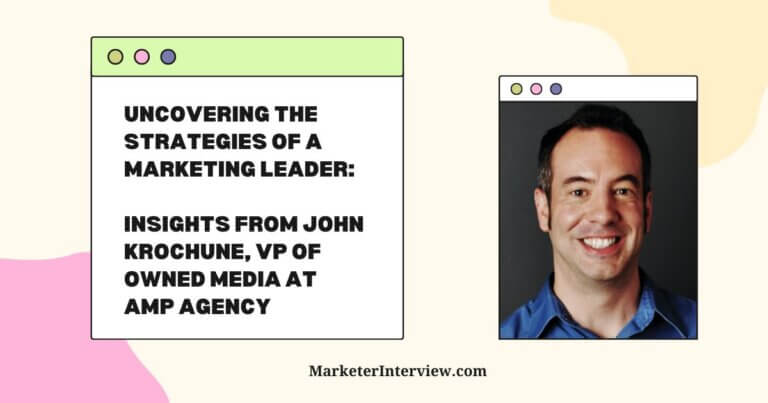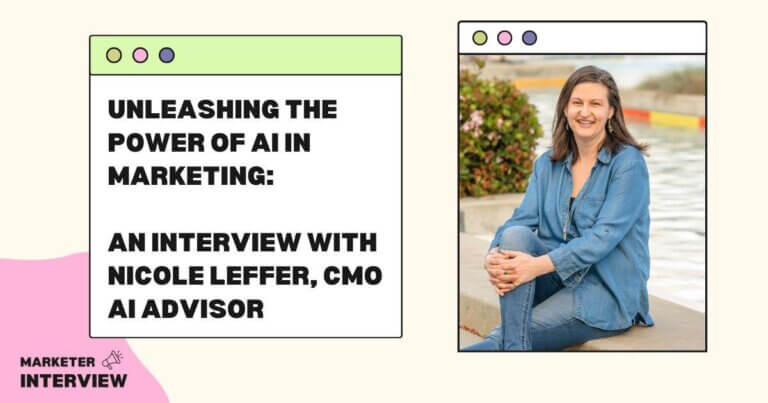The Art of Data-Driven Relationships: A Conversation with Jessica Best
Welcome to another captivating edition of Marketer Interview!
In this episode, we have the privilege of sitting down with Jessica Best, a trailblazing figure in marketing. She admits to being an email geek long before it was cool!
With a remarkable journey that spans from her role as a Digital Marketing Evangelist for an email marketing agency to her current position as the Owner and Chief Strategist of BetterAve, Jessica has not only witnessed but actively shaped the evolution of email marketing, CRM, and data-driven strategies.
Her extensive expertise and passion for optimizing results through data analysis make her insights invaluable to marketers at every stage of their careers.
Contents
- 1 Could you share the fascinating story of how you embarked on your journey in the field of marketing, eventually becoming a prominent figure in email marketing and CRM?
- 2 Your role as a Digital Marketing Evangelist at emfluence marked a turning point. How did this experience shape your approach to marketing and lay the foundation for your future ventures?
- 3 From Digital Marketing Evangelist to Owner and Chief Strategist of BetterAve, your career has taken diverse turns. Could you provide insights into your current role and its significance in today’s marketing landscape?
- 4 Email marketing has evolved significantly over the years. What strategies do you find particularly effective today, and how do they differ from those you advocated for earlier in your career?
- 5 Your expertise lies in leveraging data for strategic success. How do you seamlessly integrate 1st party data into multi-channel campaigns to foster stronger customer relationships?
- 6 In your view, what role does CRM play in enhancing customer experiences? Could you share a specific example where your CRM strategies made a noteworthy impact?
- 7 With your extensive experience, you’ve likely encountered various challenges. Can you highlight a significant obstacle you faced in your career and the innovative solution you devised to overcome it?
- 8 As an advocate for data-driven marketing, please elaborate on the tools and software you consider indispensable for your role. How do they streamline your workflow and decision-making process?
- 9 Your speaking engagements span from Las Vegas to New York. How do you keep your presentations fresh and relevant, especially in a dynamic marketing field?
- 10 You’ve managed partnerships and comprehensive campaigns for large agency clients. How do you ensure the alignment of these initiatives with your client’s goals, and how do you measure their success?
- 11 Looking back at your remarkable journey, what advice would you give to aspiring marketers eager to excel in email marketing, CRM, and data-driven strategies?
Like many email marketers, I got into the field by accident.
I was working in a theater company, in charge of season ticket sales, and part of what we’d started doing (this was 2006) was emailing individual show ticket buyers about buying other individual show tickets or season memberships. I cringe to think about what we considered “permission” to email back then, but I fell immediately in love with email marketing’s immediacy and trackability.
As a wordsmith – but not much of a designer – I loved that I could create an email all on my own using an email platform. And I could hit “refresh” right after sending to see my results pour in: opens, clicks, and even replies to our patron services team.
I was so in love that the CEO of the email platform I was using asked if I wanted to dive full-time into email marketing. The answer was a resounding yes, and I’ve never gotten away from it!
As my career progressed, I became more of a leader/trainer of email marketers – from strategists to developers, copywriters, designers, etc. – but I never really stepped away from directly contributing strategic ideas.
I also learned that backend data connections were crucial for powering relevant, data-driven email marketing – marketing that’s relevant and, therefore, effective! I do as much data systems architecture as email marketing strategic planning these days, but I love both equally.
Your role as a Digital Marketing Evangelist at emfluence marked a turning point. How did this experience shape your approach to marketing and lay the foundation for your future ventures?
After a few years of being a Marketing Manager at emfluence, I realized I was doing more teaching and training than new client acquisition. Our current clients were an important audience for marketing materials and an essential audience for our Research & Development team as they plotted what features to build next.
I pivoted from being a content marketer – writing blog posts and emails to email marketers about email marketing – to being a full-on Evangelist, speaking at conferences on the best email marketing strategies and technology. It was a turning point in my career. I’ve been speaking for over 10 years now, all around the world, from Dubuque, Iowa, to Bucharest, Romania!
From Digital Marketing Evangelist to Owner and Chief Strategist of BetterAve, your career has taken diverse turns. Could you provide insights into your current role and its significance in today’s marketing landscape?
When I moved from emfluence to Barkley – a larger, full-service agency – in 2016, I knew I was jumping into the world of Fortune 500 brands and the highest strategic levels in the industry. I expected to stretch what I’d learned and grow exponentially. And I did!
After 7 great years at Barkley, having grown a sizable team for Barkley’s CRM department, I knew it was time to go out on my own. In January of 2023, I started BetterAve (named cleverly after my last name, Best). There’s only one BEST, but we can get BETTER, daily, using data-driven strategies.
I love this opportunity to take my “big brand” experience and bring it to companies of all sizes, especially restaurants since I got to work on Dairy Queen, Noodles & Co., Applebee’s, IHOP, Fogo de Chão, and more at Barkley.
At emfluence, I had experience working on Kansas City-based restaurant groups. Now I think I’m just the right fit to bring high-level expertise – and high Return on Investment – to dining brands that serve their regional and local communities. (Kansas City, Denver & Chicago restaurant groups are my fave!)
Email marketing has evolved significantly over the years. What strategies do you find particularly effective today, and how do they differ from those you advocated for earlier in your career?
Email has changed in many ways, and it hasn’t changed at all in some ways. It’s still a permission-based medium (which, if you were doing it right, it always was). It’s still a game of getting into the inbox, though, of course, that gets harder and easier in waves over time.
How we use space and design in email has changed, though. Unlike nearly every other channel, the real estate in email is “free” and “endless.” (Okay, not really – Gmail clips emails when they get too long, but even they have a high threshold.) We’ve learned not to abuse that free real estate.
Rather than put more words in our emails, we focus on short, skimmable sections that link to full-length content on our website or social channels. And, of course, email marketing has become much more visual and even interactive. We can use click-based polls, animated GIFs, and more. As we add more content, we always want to ensure that we use plenty of white space to fit “roomily” in the email for easy skimming and mobile friendliness.
The simplest thing that most people may not even realize has changed: Those 2-column layout newsletters with a “link table” at the top are long gone! (They weren’t very mobile-friendly.)

Your expertise lies in leveraging data for strategic success. How do you seamlessly integrate 1st party data into multi-channel campaigns to foster stronger customer relationships?
This is one of my biggest soap boxes!
Data-driven marketing – primarily data-driven email marketing – just works better. It works better because it’s better for the recipient when we use data to make emails more relevant.
Email campaigns can be sent at the right time with customized content for each recipient in scalable ways. Plus, the data in our database can help us confirm the attribution of sales to email openers/clickers and know which of our campaigns are worth re-investing in.
Data integration can be simple if you only need one master database (even if that “master database” is just an email platform full of your subscribers). If you want to feed in online orders or offline invoices or just need to feed email signups from your website, check out Zapier for getting data in/out of common email platforms like emfluence, MailChimp or ActiveCampaign.
It can also be wildly more complex, of course. Many Fortune 1000 brands I’ve worked with have over 15 data hubs. One client was shocked when I showed them that they had over 18 databases across their sales, marketing, IT, accounting, and legal functions. (Not just data sources… These were separate, distinct databases of contacts!)
We worked to build a 3-year plan to eliminate duplicate functionality and consolidate or “harmonize” to one master database and automate data integrations from the other sources to and from that master database. It’s an investment to get it done, but when you can eliminate redundant technology spend, automate what human beings are wasting time on manually (like exporting and importing data), and track in one place what efforts/campaigns are working the best… it will more than pay back your invested time and budget.
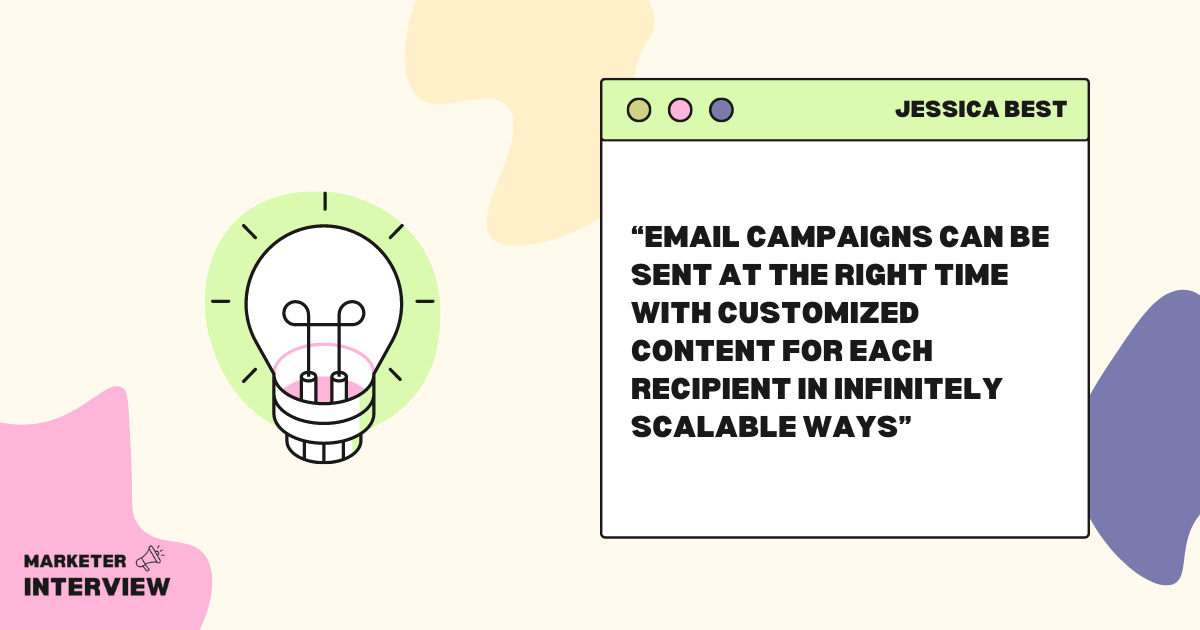
One of the best parts of email marketing being a CRM-based channel is how personal and personalized we can get.
One basic marketing automation campaign that can significantly impact is a Post-Purchase Customer Satisfaction Survey. Ask your customers how the product meets expectations thirty days after a new purchase. It can be a simple 1-question survey. For happy customers who gave you/your product high scores, automate a follow-up email to request that they write an online review or refer you to a friend or colleague.
More importantly, the follow-up to an unhappy customer should be from a live person. When CRM is genuinely well-connected, we can stop automated marketing and step in with human/call campaigns when appropriate. An unhappy first-time buyer of a $180K+ RV deserves a call from the dealer or the brand’s regional manager.
Sync your Customer Satisfaction scores to your CRM and set up alerts for low scores. If you don’t have fancy tools, simply have the survey platform email all survey responses to a manager who can spot bad scores and follow up individually.
Gathering client feedback isn’t always about getting testimonials. It’s just as often about rectifying bad experiences that can have a wave of negative impact on your audiences.
With your extensive experience, you’ve likely encountered various challenges. Can you highlight a significant obstacle you faced in your career and the innovative solution you devised to overcome it?
One of my favorite case studies is for a University client we had at Barkley. They came to us asking how they could see more return on investment from their paid media ads. They wanted more conversions, meaning students who applied for admission.
Choosing a college or university – or potentially life path – is a long-term decision. Of course, one of our first thoughts was an automated email nurture campaign. But actually, it was a job for a website overhaul, too.
Their existing site was entirely written for current students, parents, and faculty. There wasn’t even a section or page that would be a good landing page for a prospective student that came in from a Google search.
Our team not only built a microsite dedicated to prospective students considering their options, they built it in a way that collected data that could power nurture campaigns. The microsite’s landing page had 4 clear paths/click trails that led the student to the right course load, financial aid options, and even class rosters for their interests.
If a prospective student filled out a lead form to have more information sent to them, we captured all their web visit data so that follow-up emails could be tailored to each prospect’s program, campus, and financial needs. (We also had to set up the university’s first-ever marketing automation platform in order to launch a nurture campaign: that was an exercise in data systems management!)
This University campaign won awards for its approach: solving a bigger problem than we were initially asked to, plus making an astronomical return on investment, with a significant lift in return visits to the site and clicks to Apply, ultimately representing a 200% return on marketing dollars spent and converting a lot more of our paid media leads.
As an advocate for data-driven marketing, please elaborate on the tools and software you consider indispensable for your role. How do they streamline your workflow and decision-making process?
You can use nearly any tool to put data to work for you/your campaigns.
People always ask me what my favorite email platform is – I’m still very partial to the emfluence email marketing platform – but MOST email platforms have the essential functions you need to do basic data-driven email marketing. It comes down to how advanced you want your strategy to be vs. how much you have to spend on MarTech &/or what staff you have in the CRM department.
You might need an enterprise-level CRM that ties sales activity to automation throughout the sales & even onboarding process without having to be manually managed by a salesperson, marketer, or customer service rep. This typically takes IT or operations time to keep data connections working and up to date.
Or you might need an all-in-one, easier-to-use CRM built on the same database as your email marketing, cutting out the middle step of integration. This can be run by a one-person CRM team with relative ease.
My biggest tip for MarTech is to ensure that the tech fulfills your needs rather than the other way around. Don’t get stuck in the trap of getting excited about a new piece of technology and then diverting your attention to making sure you use its shiniest features vs. staying focused on your highest ROI priorities. Buy the MarTech tools to help you achieve your goals for the year.
Your speaking engagements span from Las Vegas to New York. How do you keep your presentations fresh and relevant, especially in a dynamic marketing field?
The honest answer is that I still do the work!
I’m learning every week, with every client project, what works and what doesn’t. What nuances exist between industries (nonprofit vs. restaurants vs. packaged goods)? What new capabilities email marketing platforms are adding?
I always leave time for discussion or questions at the end of most presentations. I want to answer the questions folks had in their minds when they decided to attend my session or seminar. That teaches me a lot about what worries are on marketers’ minds these days.
I also read a lot. I’m a data privacy nerd and try to stay as up-to-date as possible on the fast-changing landscape of consumer privacy expectations and legal requirements on data capture storage and usage in marketing and across a company’s systems.
Lastly, test things! One of the components of nearly every strategy I help a client develop is a testing strategy. Understand what works for your specific product, audience, price point, and brand identity by testing the frequency, language, and offers that work for you.
You’ve managed partnerships and comprehensive campaigns for large agency clients. How do you ensure the alignment of these initiatives with your client’s goals, and how do you measure their success?
Being a data-driven marketer, I always plan campaigns with the data points I want at the end in mind.
Before running A/B tests on copy, creative, or cadence, we always define which metric will declare the winner. Before we plan email channel strategy, we identify how to segment or personalize campaigns to be uniquely relevant. Most importantly, we always know what metric matters in measuring the success of our campaigns.
The Key Performance Indicator (KPI) or primary metric we want to impact should be in the kickoff brief before we create any campaigns. (If you don’t work at an agency, you can still write briefs for your campaigns! Outline who the email is for, specify segmentation and personalization, and always state what metric you’re trying to impact and/or what benchmark you want to beat.)
Beware of channel-specific metrics. They can be helpful for a channel-specific marketer, like email marketers, to determine top-performing campaigns or let us know we’re onto something, but when talking to a broader team, you’ll want to ladder up your successes to ones that make the company happy. That means you want more leads, transactions, or revenue attributable to your efforts.
This can be tough for indirect or offline sales, but you can use a proxy metric! For example, one of my manufacturing clients could only be purchased at large (offline) home improvement stores. As a proxy metric, they tracked “Where to Buy” events on their website and counted them as a leading indicator to predict a sale offline.
Looking back at your remarkable journey, what advice would you give to aspiring marketers eager to excel in email marketing, CRM, and data-driven strategies?
Just dive in!
Approximately zero people in email marketing got a formal education in email marketing. You won’t know it all, but start reading, testing, and trying things now, and you’ll be a sought-after email marketer in no time. If you’re interested in a channel that can create 1-to-1 versions and relationships (and drive trackable results), then you’re well suited to learn the world of email marketing.
I’ve told many a college classroom: If you don’t know what marketing arena you want to focus on but have a favorite brand you’d love to work on, get into email marketing and then watch for openings on the CRM team at that brand. With 2+ years of experience, chances are you can get a spot on a team at any brand you love, and they’d be glad to have you and your dedicated email marketing expertise!
